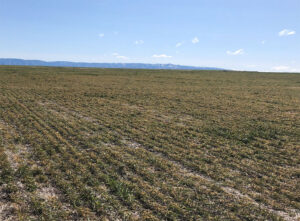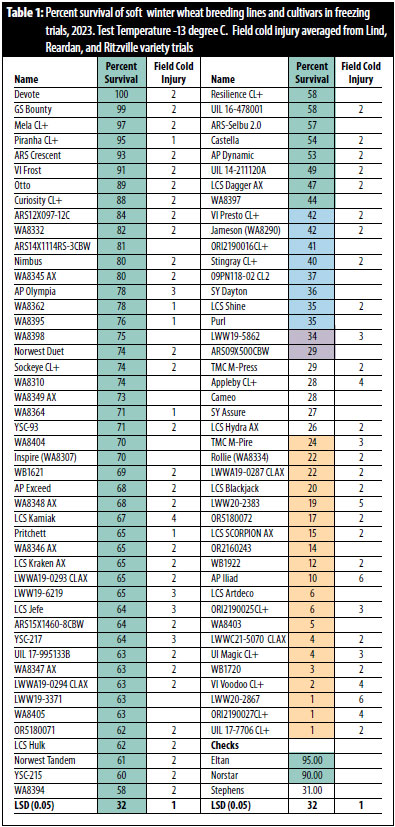Predicted increase of winter rain vs. snow could leave plants more vulnerable
By Kimberly Garland-Campbell
Winter injury continues to be a major wheat production risk in the Pacific Northwest (PNW) and globally. Although future climate models predict a 1-2 degree Fahrenheit increase in annual mean temperatures between 2010 and 2039, much of this increase is expected to occur during the summer months, which will cause the crop to mature more rapidly. The predicted increase in winter rain and decrease in snow cover will leave crops more vulnerable to sudden temperature drops during the fall and winter. We recently experienced severe winter weather in December 2022. Many growers lost stands along Highway 2 and on the north slopes of exposed fields.

After planting, winter wheat emerges and goes through a gradual reduction in temperatures during the fall. Ironically, winter wheat requires this cold acclimation, which is called vernalization, before switching from vegetative to reproductive growth. Once the vernalization requirement is met, cold tolerance decreases, and reproductive growth begins. In Washington, most winter wheat requires about eight weeks of vernalization, so the vernalization requirement is met during the month of January.
Flowering doesn’t occur in January, however, because winter crops also regulate their switch to reproductive growth using photoperiod, a requirement for a specific day length. The photoperiod requirement protects the wheat from responding to sudden warm temperatures in January and February when the probability of severe winter weather is still high.  The photoperiod requirement is correlated to latitude and finely tuned so that wheat in Oregon will begin reproductive growth earlier in early February when days are still short, while wheat in Washington waits until days are longer in late February and March.
The photoperiod requirement is correlated to latitude and finely tuned so that wheat in Oregon will begin reproductive growth earlier in early February when days are still short, while wheat in Washington waits until days are longer in late February and March.
Wheat is particularly susceptible to extreme cold at specific time points in crop development. One is soon after planting, before the crop is adequately acclimated to colder weather. In the PNW, this often occurs in late November. After about four to five weeks of freezing weather, winter wheat is maximally tolerant to freezing temperatures. Then, after eight weeks, when the vernalization requirement is met, winter wheat becomes vulnerable to cold again. In Washington, this usually occurs in late January and early February when the switch to reproductive growth has occurred, but the crop is being held back by its photoperiod requirement. Drive along any of the east-west highways in Eastern Washington in the spring, and you can often see loss of exposed stands due to winter injury that occurred with freezing temperatures on exposed ridges.
 Sudden temperature swings in February and March damaged the crop in Washington in 2014, 2015, 2017, 2019, 2020, and 2023 and are a problem in parts of the wheat-growing region every year. Screening for winter hardiness in the field is difficult because winter-kill varies across a field. We developed artificial freezing trials that are correlated with freeze injury due to winter injury. We have used these artificial screening trials in the Washington State University (WSU) Plant Growth Facility to assess cultivars and breeding lines in the WSU Cereal Variety Trials since 2001. We have also used these trials to select for cold tolerance among winter wheat breeding lines for the WSU and U.S. Department of Agriculture (USDA) breeding programs, to rate lines for resistance and to evaluate spring variety trials and to conduct basic research to identify genes and genetic interactions affecting freezing tolerance in winter wheat. Winter survival is under genetic control, and we can breed for better winter survival in wheat and barley.
Sudden temperature swings in February and March damaged the crop in Washington in 2014, 2015, 2017, 2019, 2020, and 2023 and are a problem in parts of the wheat-growing region every year. Screening for winter hardiness in the field is difficult because winter-kill varies across a field. We developed artificial freezing trials that are correlated with freeze injury due to winter injury. We have used these artificial screening trials in the Washington State University (WSU) Plant Growth Facility to assess cultivars and breeding lines in the WSU Cereal Variety Trials since 2001. We have also used these trials to select for cold tolerance among winter wheat breeding lines for the WSU and U.S. Department of Agriculture (USDA) breeding programs, to rate lines for resistance and to evaluate spring variety trials and to conduct basic research to identify genes and genetic interactions affecting freezing tolerance in winter wheat. Winter survival is under genetic control, and we can breed for better winter survival in wheat and barley.
Our most recent survival ratings are listed in Tables 1-3. We test the winter wheat at minus 13 degrees C to get a good spread in the survival data. This is a more severe temperature than wheat will experience in the field, so the most susceptible lines in our trials have no survival, while they often would be expected to have 30-50% survival in the field. It’s important to compare our results to the survival of the resistant check, Eltan, and the susceptible check, Stephens, to correctly interpret the data. These data are updated each year as a part of the WSU Extension small grains variety selection tool.
 Following the severe winter weather in December 2022, WSU Cereal Variety Testing Lead Clark Neely was able to rate cold injury in the 2023 variety trials at Reardan, Lind, and Ritzville on a 1 to 9 scale, where 1 equaled no cold injury. The winter survival ratings that we achieve with our artificial screening system are correlated to field results.
Following the severe winter weather in December 2022, WSU Cereal Variety Testing Lead Clark Neely was able to rate cold injury in the 2023 variety trials at Reardan, Lind, and Ritzville on a 1 to 9 scale, where 1 equaled no cold injury. The winter survival ratings that we achieve with our artificial screening system are correlated to field results.
Due to the interest in planting hard red spring wheat in the fall, we also screen the spring wheat and are beginning to screen winter barley breeding lines for Oregon State University and WSU. We learned that the lowest freezing trial test temperatures of minus 6 to minus 9 C are best for the spring wheat and barley. We kill everything at lower test temperatures. While there are differences in survival among spring wheat and winter barley lines, none of them are as tolerant as even our susceptible winter wheat check, Stephens.
In general, susceptible winter wheat and all spring wheat and winter barley are riskier to plant north of Highway 26, but other winter wheat will generally survive unless there is severe disease pressure such as snow mold. Root and crown diseases, like snow mold and fusarium crown rot, will kill wheat off regardless of its winter injury rating, so breeding for resistance to those diseases is also important for winter survival.
This article originally appeared in the February 2024 issue of Wheat Life Magazine.

Kimberly Garland-Campbell, Ph.D.
Kimberly Garland Campbell is a USDA plant research geneticist and club wheat breeder at the USDA-ARS in Pullman, Washington. Her research focuses on genetics and breeding of wheat responses to abiotic and biotic stress; breeding wheat for winter survival; enhancing quality, functionality and marketability in the in the western U.S. of soft white and club wheat; and control of rusts of cereal crops. Read more about Dr. Campbell.
